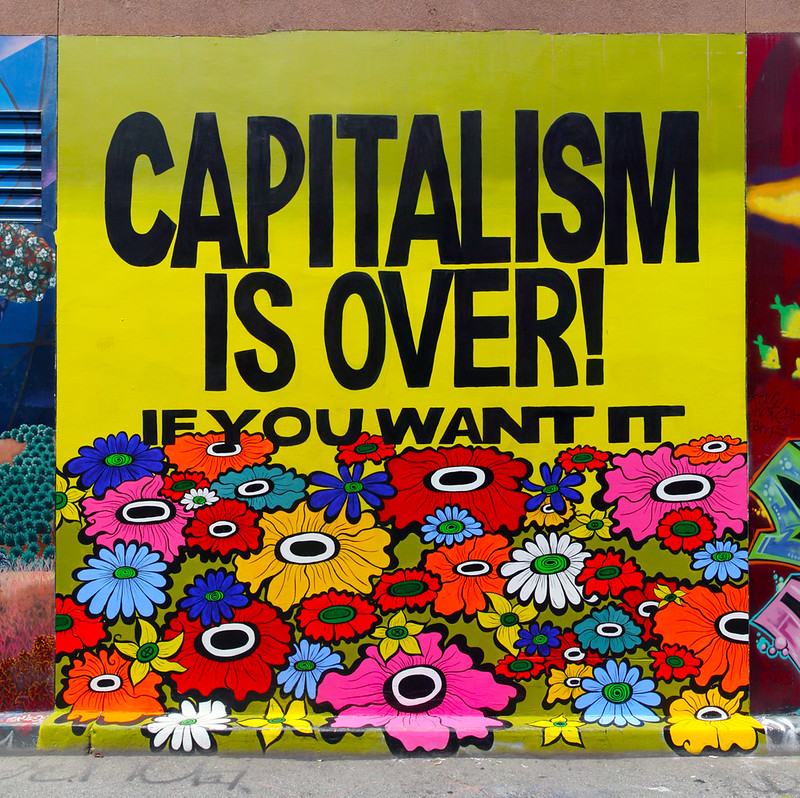Foretelling the End of Capitalism: Intellectual Misadventures Since Karl Marx
Francesco Boldizzoni
Harvard University Press, $35 (cloth)
It’s been a rough decade for capitalism. Since the 2008 financial meltdown crashed the global economy, capitalism has been subjected to renewed scrutiny by everyone from Bernie Sanders to the Financial Times; now a global pandemic has put new strain on a system that has barely recovered from the last crisis. Tens of millions are out of work globally, and growth has plummeted as economic activity has ground nearly to a halt. A huge swath of the private sector—not just individual firms but entire industries—is on state-sponsored life support, propped up by low-to-zero-interest loans and massive bond purchases.
The world appears headed for a sustained economic crisis on a scale not seen since the Great Depression. Is this the beginning of capitalism’s end?
Even so, the world appears headed for a sustained economic crisis on a scale not seen since the Great Depression, and with the potential to outpace even that. Yet the stock market remains relatively buoyant; Jeff Bezos, at least, has made billions. The disjuncture between what is good for profits and what is good for human life is starkly on display in calls to “reopen the economy” even while the virus remains uncontained; the gap between those with second homes and those with low-wage service sector jobs is more blatant than ever. Meanwhile the climate crisis creeps along: last month the average global temperature was the second highest on record for April, following only April 2016. Is this the beginning of capitalism’s end?
If you think it might be—whether you are eagerly awaiting capitalism’s collapse or anxiously anticipating it—Francesco Boldizzoni’s new book Foretelling the End of Capitalism: Intellectual Misadventures Since Karl Marx will make you think twice. There’s an old joke about the Marxist economist who predicted fifteen out of the last three recessions. The core of this book is about the Marxists—alongside some liberals and conservatives—who predicted four out of the last zero ends to capitalism. Boldizzoni takes us on a (very white, very male) tour of modern European and American social thought, detailing what he describes as the “misadventures” of those who have predicted capitalism’s downfall. They begin in 1848, amidst the revolutions that swept Europe, when Boldizzoni argues “the term ‘capitalism’ was born.” From there, Boldizzoni takes intellectual history a few decades at a time: from the late Victorian era to the interwar period, then to the postwar “golden age,” and finally, from the “end of history” to the present.
• • •
There are, Boldizzoni argues, four kinds of predictions. There are theories of implosion, wherein capitalism collapses because of pressures that arise from the workings of its own logic. There are theories of exhaustion, which predict capitalism will “die of natural causes”—it runs up against environmental limits, or moral advances enable people to move beyond it. There are theories of convergence, wherein capitalism and socialism become more and more alike, appearing as mirror images of modern rationality and bureaucratic organization. Finally, there is “cultural involution,” wherein capitalism kills off the non-economic values that made it work in the first place. Some of these tendencies seem more significant than others: theories of implosion, for example, recur far more frequently than theories of convergence.
Karl Marx, as the book’s subtitle suggests, is the original prophet of capitalism’s end as well as the foremost theorist of the implosion school. Marx outlined how capitalism worked, but he also introduced the idea that capitalism contained within it the seeds of its own destruction. Capitalism, in his account, was plagued by contradictions: the rate of profit inexorably fell, meaning that capitalists would have to squeeze labor and nature harder and harder to make less and less money; it tended to produce more goods than the market could absorb, and to immiserate its workers such that they could not afford the goods they produced. It also produced its own “grave-diggers”: a mass of people, the proletariat, who own nothing but their own labor, and who would eventually realize their shared interest in overcoming the few who own everything else.
There’s an old joke about the Marxist economist who predicted fifteen out of the last three recessions. This book is about those who predicted four out of the last zero ends to capitalism.
These two elements—capitalism’s internal contradictions, and the agency of the class it created—would root many subsequent critiques: Marx’s followers, Boldizzoni argues, have “wavered between a rather mechanistic interpretation of crisis and its opposite: the conviction that capitalism could only be overcome by an act of will.” As capitalism goes through crisis after crisis, from the Great War to the Depression, stagflation to Great Recession, various thinkers following Marx’s lead develop new iterations of crisis theory, each focused on a different element of an evolving capitalism: Vladimir Lenin and Rosa Luxemburg point to imperialism, Claus Offe and James O’Connor to the contradictions embedded in the capitalist state.
The liberal thinker John Stuart Mill, by contrast, is paradigmatic of the exhaustion theory. Although Mill was sympathetic to socialism and at times even to communism, he was no revolutionary. Rather, he argued that capitalism would gradually settle into a “stationary state” when both the drive to accumulate wealth and the physical sources of wealth had been exhausted. Such a state, he thought, would represent a “very considerable improvement” on the “trampling, crushing, elbowing, and treading on each other’s heels” that characterized a life of economic competition. Decades later, the economist John Maynard Keynes would likewise suggest that capitalism would eventually, once it had adequately developed its productive capacities, give way to a system where people could live leisurely lives in pursuit not of money but higher goods.
Theories of convergence emerged in the early twentieth century, when state intervention in the economy, whether social democratic or fascist, heralded the emergence of some new hybrid characterized by both markets and planning, while technological development and bureaucratic rationality rendered complex modern societies increasingly alike—a phenomenon analyzed by thinkers like Rudolf Hilferding and Friedrich Pollock. Cultural involution, meanwhile, is the province of thinkers like Herbert Marcuse on the left and Daniel Bell and Joseph Schumpeter on the right. Where Schumpeter bemoaned the decline of the entrepreneurial spirit and Bell the way that consumer decadence had replaced thrift and hard work, for Marcuse these apparent symptoms of hedonism appeared as liberation from capitalist rationality.
This is just a small sample of the dozens of thinkers Boldizzoni addresses, not all of whom fit neatly into this outline. The first four chapters move quickly through a series of proficient and deftly connected capsule summaries of thinkers across a range of fields, from economics to philosophy to sociology. Although those who have spent more time with these authors may occasionally be frustrated by the glosses of complex arguments, the point is not to cast new light on any one idea, but to show, through volume and range, the many ways that people have thought about capitalism’s end, and the many ways they have gotten it wrong: thus far none of the predictions has proved correct.
It’s only in the final chapter that Boldizzoni finally articulates his own view of what capitalism actually is and offers his account why it has outlasted so many of its critics. Capitalism has three core “building blocks,” he argues: minority control over the means of production, the use of markets to allocate goods and resources, and a “bourgeois culture . . . oriented toward the acquisition of wealth for personal purposes.” In turn, these conditions require a “hierarchical social structure” and an “individualistic orientation”—features more deeply embedded in Western culture than most of capitalism’s critics have recognized, and more crucial to capitalism’s longevity than they have credited. The political, economic, and social structures of society, he argues, “are held together in a coherent way by a powerful glue: this glue is called culture, and its molecules are the meanings that humans associate with their actions, with those of their fellow humans, and with existence in general.”
The history this book tells is framed as a set of hard truths for a well-meaning but naïve left. But no one is sitting on their hands waiting for the end.
Against a boilerplate reading of Marx as a crude economic determinist, Boldizzoni declares that culture is not mere “superstructure,” but rather relatively autonomous and often governed by inertia. In fact, he suggests, the structure of many contemporary societies is in part a holdover from previous historical moments: Norway, for example, is among the least stratified of modern societies in part because it never had a truly feudal structure, and because its extreme natural conditions forced the development of cooperative relationships between people living in small communities. (Interestingly, Thomas Piketty’s new book Capital and Ideology, despite pitting a similar view of autonomous ideology against a putatively Marxist determinism, argues precisely the opposite about the origins of inequality, showing that Nordic social democratic egalitarianism is a recent development rather than essential quality.) Because culture changes slowly and gradually, capitalism, which is embedded in culture, will too.
Boldizzoni’s centering of culture, moreover, makes capitalism look like a distinctively Western system. Most non-Western countries, he argues, including China, Russia, and potentially India and Brazil—the BRIC economies that just a few years ago heralded capitalism’s bright future—“cannot be characterized as capitalist.” The Chinese economy certainly looks different from, say, the U.S. one, but the two are so deeply imbricated that it makes little sense to describe them as fundamentally different systems. It is hard to understand contemporary capitalism without China, even if its internal organization is ambiguous. So why does the case of China not simply augur a variation on a theme—capitalism with Chinese characteristics? Piketty shows that since liberalization, inequality in China has skyrocketed and now exceeds Europe’s—is this not evidence of hierarchy? Are China’s billionaires not driven by an individualistic orientation toward wealth accumulation? Statements like “outside the West there is a lack of cultural elements to support capitalism” do little to illuminate the supposed distinction, and the implication that the entire “East” is culturally collectivist borders uncomfortably on orientalism.
These appeals to “culture,” then, may well obscure more than they illuminate. Whether or not people think of themselves as individuals, if they want to make shoes or bread or bicycles in a capitalist society, they will have to compete with others to survive; they will be compelled to keep prices down, and keep costs down further. What is extraordinary about capitalism as a system, as Marx observed (even as he sought to identify its fragilities), is that it is self-perpetuating: propelled by an internal logic that has triumphed over many other ways of organizing the world, even if it has not eradicated them altogether. People have often resisted its imperatives, of course, and fought to preserve other ways of life—and sometimes they have even succeeded. While capitalism has never come to an end everywhere, after all, it was defeated in some places for at least some period of time. It would have been useful for Boldizzoni to consider what people in those places—Cuba, China, Russia, Vietnam—thought about capitalism and why they sought to build something else. (Boldizzoni simply states Russia “lacked an individualist social pattern.”) But in this book revolutions take place merely as the backdrop to social thought, subject matter for social scientists to chew on.
For Boldizzoni, the political, economic, and social structures of society are held together by the “powerful glue” of “culture.” But that vague appeal is far too complicated to do the work he wants it to.
Boldizzoni’s vague appeal to “Western culture” as the explanation for capitalism’s perseverance is still more frustrating in light of his lack of engagement with scholars who have seriously analyzed the relationship between social relations deemed “cultural” and those deemed economic. Cedric Robinson’s Black Marxism (1983), for example, also locates capitalism’s origins in an older Western tradition, but it puts race, and “racialism,” at the center of analysis, as the system’s sine qua non. Scholars like Melinda Cooper, meanwhile, have argued that the family—perhaps the “cultural” institution—is fully internal to capitalism and shown how it has been remade accordingly. And although Boldizzoni cites Nancy Fraser’s view of capitalism as an “institutionalized social order,” his own definition seems to be the opposite of hers: whereas Boldizzoni sees culture as relatively autonomous, Fraser describes culture as deeply imbricated with capitalism. “Culture,” that is, is far too complicated to do the work Boldizzoni wants it to.
He is on firmer ground when he suggests that the more deeply rooted capitalism is in our ways of life, the more difficult it will be to rip out. He grants that capitalism will end eventually, like all other social and economic systems humans have devised—it just won’t end anytime soon. A line from Ursula K. LeGuin now circulates widely on the left: “We live in capitalism. Its power seems inescapable. So did the divine right of kings.” To this, Boldizzoni might add: sure, but ending the divine right of kings took a millennium.
For all his critique of false prophets, Boldizzoni cannot quite refrain from some prognostication of his own. Globally, he argues, capitalism will actually shrink as U.S. power wanes—plausible only if you buy his reading of China as non-capitalist. In the Western capitalist core, tensions between “national citizenries” and “cosmopolitan élites” will continue to heighten; the populist right, Boldizzoni thinks, is more likely to win out than the progressive left.
This book is meant as advice for the latter: a cautionary tale for millennial Marxists who are dismayed by capitalism’s manifest injustice and eager to do something about it. Although Boldizzoni is sympathetic to their goals, he suggests that they need to take a hard look at the track record of their predecessors and get real about what’s possible. In the United States, he suggests, most self-declared democratic socialists are really social democrats, which is all well and good: Boldizzoni himself believes social democracy is the best way forward. Those who do “really wish to end capitalism,” meanwhile, are deluding themselves about the likelihood that capitalism will come to an end, whether by collapsing under its own contradictions or by succumbing to revolution. “Coming to terms with reality is rarely a source of lasting satisfaction and is often a frustrating exercise that does not attract much sympathy,” Boldizzoni chides, “but it is the only reasonable thing to do.” Accepting that capitalism is here to stay doesn’t mean giving up on making things better. “Every step to redress [racial and economic] imbalances, no matter how small, is an important one, and every result is an achievement.”
If capitalism endures through coming centuries, as Boldizzoni suggests it will, it will be because it can shrug off the deaths of millions of people and the extinction of thousands of species.
The history this book tells is thus framed as a set of hard truths for a well-meaning but naïve left. Boldizzoni dismisses both the “sensational or apocalyptic tones in public discourse” and what he describes as the “Dada-Marxism” prevalent on Twitter. But I think he has misunderstood his audience. No one knows better than the left, even the “new new left,” that capitalism’s end has been oft foretold. Very few contemporary critics of capitalism evince certainty that it will collapse or that revolution is imminent; no one is sitting on their hands waiting for the end. Rather, I think, most of today’s left is motivated by the desire to stave off the horrors that await if capitalism continues, pointing to its increasingly maniacal trajectory not as a sign that it is on the outs but as a warning of what is yet to come.
Many of the analyses Boldizzoni discusses remain valuable to such a project, if imperfect, and while it is important to take stock of their shortcomings, it is nevertheless grating to see those who have thought seriously about capitalism’s dynamics reduced to false prophets of its doom. Those who have “forecast” capitalism’s demise, after all, have usually done so in the course of attempting to understand how it works.
It is clear enough that capitalism is currently beset by a number of structural weaknesses. Even before a global pandemic brought daily life to a halt, there were signs of trouble. Capitalism in the West has suffered from slowing growth, a phenomenon known as “secular stagnation” and remarked on even by capitalism’s advocates. Trumponomics briefly boosted growth by tapping out state tools like low interest rates (though never low enough for Trump’s taste), yet while the number of jobs had grown steadily for several years before COVID-19 hit, wages had not. The Western trajectory of industrialization appears to be exhausted: global markets are already crowded, leaving little room for “emerging markets” to develop. Even the phenomenal growth rates of China and India had begun to slow before the pandemic hit. There are reasons to think that capitalism is running out of “fixes”—there are fewer peasants to be converted to low-wage proletarians, fewer places for production to be outsourced, fewer sites (the moon?) from which to extract resources. Yet analysts have thought as much before, and capitalism has gotten out of plenty of tight spots thus far.
Boldizzoni suggests that what he calls “forecasting” is the folly of social scientists; it seems that he would prefer they refrain from predictions altogether. Yet it is hard to see how we could do without them. It strikes me as preferable for those who have studied our social and economic order in depth to make at least some conjectures, however fallible, about what may come rather than to renounce the practice entirely. Epidemiologists and public health experts, for example, had anticipated a pandemic for years, based on a mix of scientific facts and analyses of social conditions: what might have appeared as a false alarm in 2019 now looks like foresight.
The book, of course, was written before the pandemic that now hangs over its theme (though the cover, eerily enough, features an image of a grim reaper). But it seems likely that Boldizzoni would class it with what he describes as “external” threats to capitalism, as he does environmental crises. These he addresses rather perfunctorily, with a few paragraphs on Mill’s concern for a vanishing nature, and a few more on the wave of environmental alarm that emerged in the 1970s. But the pandemic (like climate change) can hardly be understood as exogenous to capitalism: the virus itself is the outgrowth of the periurbanization that has accompanied rapid development, the commodification of once-wild subsistence foods, new encounters between humans and nonhumans driven by industrial food production, and the global movement of both people and commodities. The disease’s devastating impact in the United States, meanwhile, is an entirely predictable effect of the free market ideology and racialization of state support that has decimated public health preparedness, militated against the provision of universal health care, and refused adequate assistance to those out of work.
It is true that even problems endogenous to capitalism may not destroy it—at least not immediately. The environmental problem, Boldizzoni notes, may represent a serious threat to human well being, but it is not a threat to capitalism. After all, “capitalism has shown that it does not need clean air to thrive, but only air that is barely breathable.” Fair enough: as long as the reserve army of labor is large enough, people can even sicken and die from pollution and the damage it causes, as they are currently doing—those who have suffered exposure to air pollution are at greater risk of death from COVID-19. We are headed, however, for a future in which parts of the world will be essentially uninhabitable within decades. Even that may be something that capitalism can survive: after all, capitalism does not need every part of the world, nor every person living in it.
Those who recognize that capitalism may not end soon need not simply accept it.
Mike Davis reminds us—as he has repeatedly over the years—that “the survival of the poorest fifth of humanity is increasingly at question.” (Davis’s 2005 book The Monster at Our Door: The Global Threat of Avian Flu, now frequently described as “prescient,” serves as a reminder that critics of capitalism have also made plenty of accurate predictions.) If capitalism endures through coming centuries, as Boldizzoni suggests it will, it will be because it can shrug off the deaths of millions of people and the extinction of thousands of species. It is often capitalism’s defenders who laud its versatility and endurance. But in fact, the more brutal it is, the longer it can last. It has already survived wars that killed millions and destroyed entire cities; it will survive the fires and floods and droughts to come, and possibly even find new opportunities for accumulation in the process of rebuilding—at least for a while. At some point, of course, ecological breakdown will be too severe for capitalism to continue to function. But by then, there may not be much hope that anything else can continue functioning either.
So I’m sympathetic to Boldizzoni’s case for pragmatism. I may be certain that capitalism will eventually destroy Earth’s biosphere, but I can also recognize the danger of pinning hopes for the preservation of the latter on the end of the former. I am not convinced, however, that those who recognize that capitalism may not end soon must simply accept it. I hope I’m wrong about our prospects: I would love nothing more than for this review to provide the fodder for an intellectual historian living happily in the eco-socialist future to point out the undue pessimism of the pandemic era, the false predictions made by those of little faith. In the meantime, I think it is imperative for those who think capitalism should come to an end to explain as clearly as possible why, and to do what they can to bring that end about. Intellectual adventures may be able to avoid the future, but political ones cannot. There are worse things, after all, than being wrong.






